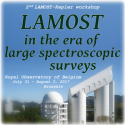Speaker
Ms
Li-Ching Huang
(Institute of Astronomy, National Central University, Taiwan)
Description
The Kepler space telescope has observed more than 2000 eclipsing binary (EB) systems during its primary mission between 2009 and 2013. According to the effective temperatures measured by Huber et al. (2014), we have selected about 131 systems with G-type primary stars characterized with Teff ~ 5000K-6000K for a statistical study. These classifications are compared to the spectral measurements of LAMOST. Many of the binaries are characterized by the EA (Algol)-type light curves of detached systems. To calculate their spectral types, mass ratio, radius, system incline angles, and orbital distance between the two components in individual EBs, we measured their primary and secondary eclipsing transit depths and effective temperature ratios according to the Kepler data. In some test cases, we can find a best fit of two spectral components from LAMOST spectra. A fraction of the EBs in this sample displayed flare activities. We found 11 systems showing flare events in their Kepler light curves. Then we compare the S-indices of EB systems with and without flare activities. Similar with the single stars with and without flares, systems with flare events usually have a higher S-index than those without. The S-index differences between binary systems are lager than that of single stars, although there are no big S-index difference between EB and single stars.
Primary author
Ms
Li-Ching Huang
(Institute of Astronomy, National Central University, Taiwan)
Co-authors
Prof.
Ali Luo
(National Astronomical Observatories, Chinese Academy of Scienes)
Han-Yuan Chang
(Institute of Astronomy, National Central University, Taiwan)
Wing-Huen Ip
(National Central University, Taiwan)
Yihan Song
(National Astronomical Observatories, Chinese Academy of Sciences, Beijing, China)

